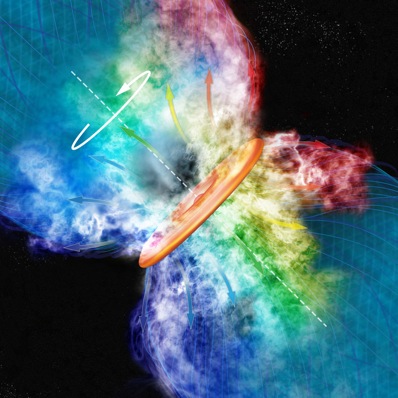
Movie reveals details of massive star formation
DR EMILY BALDWIN
ASTRONOMY NOW
Posted: November 17, 2009


A new high resolution movie of star formation based on radio images of the vast stellar nursery within Orion's Great Nebula shows that massive stars form just like their smaller siblings.
 Artist impression of the hot disc of ionized gas around Orion Source I. A cool wind of gas is driven from the upper and lower surfaces of the disc (as indicated by the colored arrows) and is sculpted into an hourglass shape by tangled magnetic field lines (shown as thin blue lines). The entire disc and winds are rotating: red colours represent material with a component of motion away from the observer while blue represents material moving towards the observer. Image: Bill Saxton, NRAO/AUI/NSF. Artist impression of the hot disc of ionized gas around Orion Source I. A cool wind of gas is driven from the upper and lower surfaces of the disc (as indicated by the colored arrows) and is sculpted into an hourglass shape by tangled magnetic field lines (shown as thin blue lines). The entire disc and winds are rotating: red colours represent material with a component of motion away from the observer while blue represents material moving towards the observer. Image: Bill Saxton, NRAO/AUI/NSF.
The glowing gas of the nebula is powered by a group of young stars, but behind it lies a cluster of even younger stars and gas. This youthful hotbed of star formation is so obscured by dust and gas from which the newborn stars are formed that radio telescopes are needed to reveal the hidden details. In this study one particular protostar, Source I, was probed using the National Science Foundation’s Very Long Baseline Array (VLBA). The team observed Source I at monthly intervals over two years and then assembled the individual images into a time-lapse movie.
“In astronomy, it’s rare to see changes over the course of a human lifetime. With this new movie, we can see changes over just a few months as gas clumps swarm around this young protostar,” says Smithsonian astronomer Ciriaco Goddi.
The VLBA detected thousands of silicon monoxide gas clouds called masers – naturally occurring laser-like beacons often associated with star formation – many of which existed long enough for their motions to be tracked across the sky and along our line of sight, yielding their 3-D motions through space. “Source I is the richest source of masers in the Galaxy, that we know of,” says Lynn Matthews, lead author of the research. “Without the masers, we couldn’t track the gas motions in such detail so close to this massive star, and would be relatively blind to its formation.” Some of the masers were as close to the protostar as Jupiter is to our Sun.
|



